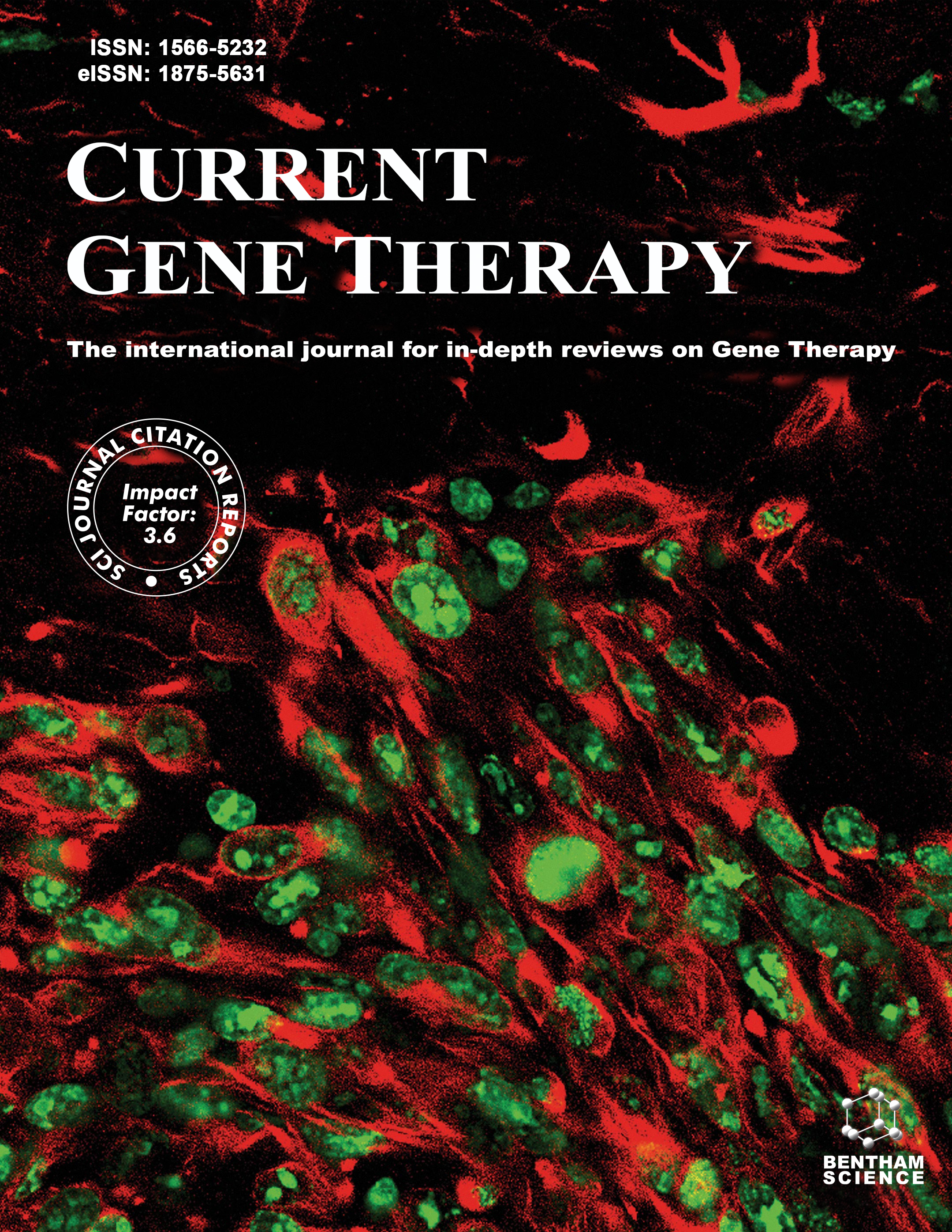- Home
- A-Z Publications
- Current Gene Therapy
- Previous Issues
- Volume 11, Issue 3, 2011
Current Gene Therapy - Volume 11, Issue 3, 2011
Volume 11, Issue 3, 2011
-
-
Editorial
More Less“Opportunities Multiply as they are Seized.” -Sun Tzu Current Gene Therapy was born with the XXI century, as a reviews journal for gene therapy, a relatively new field of biomedical sciences that was gaining in maturity and solidity. Gene therapy was the result of a progressive merging of several scientific disciplines; genetics, molecular biology, virology, immunology and the clinical research of various organs and tissues affected b Read More
-
-
-
Gene Therapy and Targeted Toxins for Glioma
More LessThe most common primary brain tumor in adults is glioblastoma. These tumors are highly invasive and aggressive with a mean survival time of 15-18 months from diagnosis to death. Current treatment modalities are unable to significantly prolong survival in patients diagnosed with glioblastoma. As such, glioma is an attractive target for developing novel therapeutic approaches utilizing gene therapy. This review will Read More
-
-
-
Adeno-Associated Virus (AAV) Vectors in the CNS
More LessAdeno-associated virus (AAV) vectors exhibit a number of properties that have made this vector system an excellent choice for both CNS gene therapy and basic neurobiological investigations. In vivo, the preponderance of AAV vector transduction occurs in neurons where it is possible to obtain long-term, stable gene expression with very little accompanying toxicity. Promoter selection, however, significantly influences the Read More
-
-
-
MVA and NYVAC as Vaccines against Emergent Infectious Diseases and Cancer
More LessAuthors: Carmen E. Gomez, Jose L. Najera, Magdalena Krupa, Beatriz Perdiguero and Mariano EstebanRecombinants based on poxviruses have been used extensively as gene delivery systems to study many biological functions of foreign genes and as vaccines against many pathogens, particularly in the veterinary field. Based on safety record, efficient expression and ability to trigger specific immune responses, two of the most promising poxvirus vectors for human use are the attenuated modified vaccinia virus Ankara (MVA) Read More
-
-
-
Current Advances in Retroviral Gene Therapy
More LessAuthors: Youngsuk Yi, Moon Jong Noh and Kwan Hee LeeThere have been major changes since the incidents of leukemia development in X-SCID patients after the treatments using retroviral gene therapy. Due to the risk of oncogenesis caused by retroviral insertional activation of host genes, most of the efforts focused on the lentiviral therapies. However, a relative clonal dominance was detected in a patient with β-thalassemia Major, two years after the subject received genetical Read More
-
-
-
BMP-9 Induced Osteogenic Differentiation of Mesenchymal Stem Cells: Molecular Mechanism and Therapeutic Potential
More LessAuthors: Gaurav Luther, Eric R. Wagner, Gaohui Zhu, Quan Kang, Qing Luo, Joseph Lamplot, Yang Bi, Xiaoji Luo, Jinyong Luo, Chad Teven, Qiong Shi, Stephanie H. Kim, Jian-Li Gao, Enyi Huang, Ke Yang, Richard Rames, Xing Liu, Mi Li, Ning Hu, Hong Liu, Yuxi Su, Liang Chen, Bai-Cheng He, Guo-Wei Zuo, Zhong-Liang Deng, Russell R. Reid, Hue H. Luu, Rex C. Haydon and Tong-Chuan HePromoting osteogenic differentiation and efficacious bone regeneration have the potential to revolutionize the treatment of orthopaedic and musculoskeletal disorders. Mesenchymal Stem Cells (MSCs) are bone marrow progenitor cells that have the capacity to differentiate along osteogenic, chondrogenic, myogenic, and adipogenic lineages. Differentiation along these lineages is a tightly controlled process that is i Read More
-
Volumes & issues
-
Volume 25 (2025)
-
Volume 24 (2024)
-
Volume 23 (2023)
-
Volume 22 (2022)
-
Volume 21 (2021)
-
Volume 20 (2020)
-
Volume 19 (2019)
-
Volume 18 (2018)
-
Volume 17 (2017)
-
Volume 16 (2016)
-
Volume 15 (2015)
-
Volume 14 (2014)
-
Volume 13 (2013)
-
Volume 12 (2012)
-
Volume 11 (2011)
-
Volume 10 (2010)
-
Volume 9 (2009)
-
Volume 8 (2008)
-
Volume 7 (2007)
-
Volume 6 (2006)
-
Volume 5 (2005)
-
Volume 4 (2004)
-
Volume 3 (2003)
-
Volume 2 (2002)
-
Volume 1 (2001)
Most Read This Month
Article
content/journals/cgt
Journal
10
5
false
en

Most Cited Most Cited RSS feed
-
-
New Hope for Intervertebral Disc Degeneration: Bone Marrow Mesenchymal Stem Cells and Exosomes Derived from Bone Marrow Mesenchymal Stem Cell Transplantation
Authors: Xiao-bo Zhang, Xiang-yi Chen, Jin Qi, Hai-yu Zhou, Xiao-bing Zhao, Yi-cun Hu, Rui-hao Zhang, De-chen Yu, Xi-dan Gao, Ke-ping Wang and Lin Ma
-
- More Less

